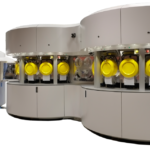Advancing Cellular‐Specific Delivery: Machine Learning Insights into Lipid Nanoparticles Design and Cellular Tropism
Advanced Healthcare Materials, EarlyView.

This study employs a data-driven approach combining design of experiments, high-throughput screening, and machine learning to optimize lipid nanoparticles (LNPs) for targeted delivery to immune cells. By exploring 180 LNP formulations with varied compositions, this work identifies key properties enhancing immune cell specificity while reducing liver uptake. In vivo validation demonstrated preferential spleen expression, successfully redirecting LNP tropism beyond hepatic cells and expanding therapeutic potential.
Abstract
Lipid nanoparticles (LNPs) have gained significant attention as effective nucleic acid delivery vehicles. Despite their success, LNPs are predominantly liver-targeted which limits their broader application. To expand the therapeutic potential of LNPs, this work implements a data-driven approach that combines design of experiments (DoE), high throughput screening (HTS), and machine learning (ML) to tailor LNP formulations for preferential immune cell targeting. This methodology involves the generation of 180 LNP formulations, with varying lipid molar ratios and lipid chemistries, to explore a diverse design space. This work aims to identify LNP properties that enhance immune cell specificity while reducing hepatic uptake. The in vitro screening of these LNPs provided a rich dataset for ML analysis, leading to the identification of promising candidates with improved immune cellular selectivity profiles. These findings are validated in vivo where it is demonstrated that selected LNPs achieved preferential spleen expression with a successful redirection of LNP tropism beyond hepatic cells. This workflow highlights the importance of tailoring LNP compositions for the development of LNPs with selective cellular tropism.




















































































































































